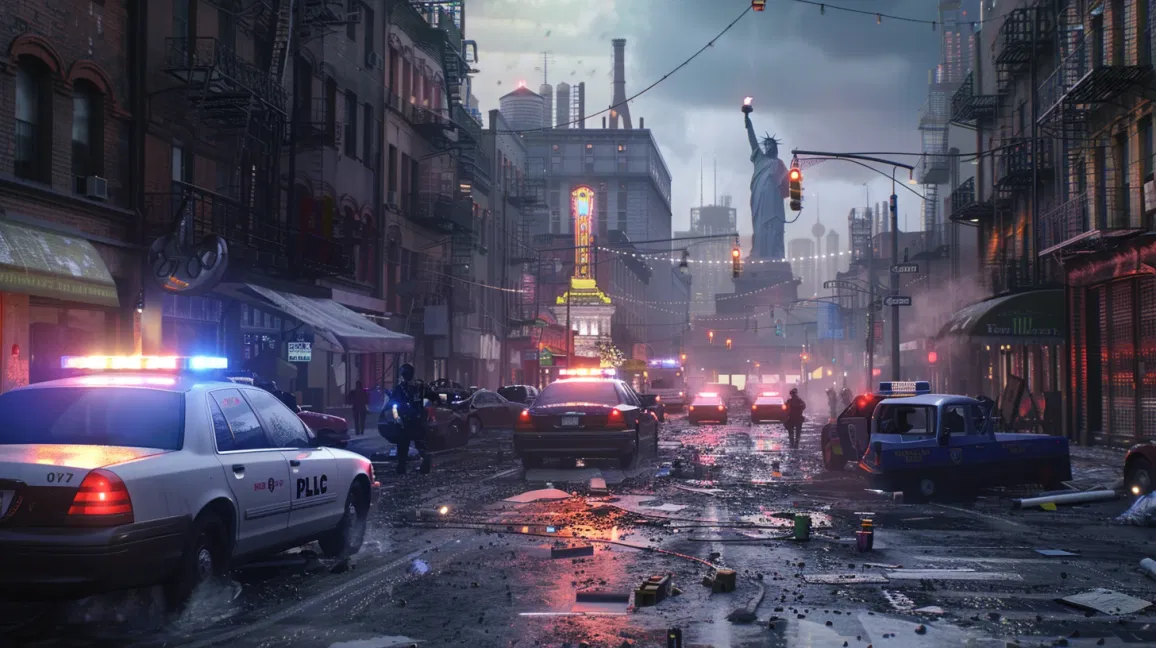New York City is a vast metropolis known for its population, iconic landmarks, and rich cultural heritage. While it serves as a centre for finance, culture, and entertainment, the city also grapples with challenges related to crime and safety. Some neighbourhoods in NYC experience higher crime rates. This article will examine the 12 most dangerous areas in New York City, drawing on crime statistics, trends, and reports.
| Overview of Dangerous Places In New York City | |||
| Neighbourhood | Population | Violent Crime Rate (/100k) | Property Crime Rate (/100k) |
| East Harlem | 121,147 | 1,616 | 2,938 |
| South Bronx | 94,230 | 1,155 | 1,901 |
| Bedford-Stuyvesant | 234,457 | 1,065 | 1,837 |
| Brownsville | 47,457 | 1,264 | 1,546 |
| Jamaica | 131,773 | 874 | 1,519 |
| East New York | 147,562 | 1,095 | 2,176 |
| Fordham | 48,002 | 1,238 | 2,331 |
| Canarsie | 86,694 | 486 | 1,385 |
| Tremont | 55,743 | 1,233 | 1,665 |
| Rockaway | 119,512 | 795 | 1,371 |
| Hunts Point | 11,425 | 1,944 | 2,613 |
| Mott Haven | 51,253 | 2,039 | 3,142 |
Top No-Go Areas In The New York City
The highest crime rates were recorded in the late 1980s and early 1990s during the crack epidemic and then declined continuously from around 1990 throughout the 2000s. As of 2023, New York City has significantly lower rates of gun violence compared to many other large cities. However, it is important to avoid the following high-crime areas in New York City:
Brownsville
New York City, like many major urban areas, has neighbourhoods that experience higher levels of crime compared to others. These areas often face various socio-economic challenges, contributing to their crime statistics. One such area is Brownsville, known for its significant crime rates.
High Crime Rates: Brownsville is recognised as one of the most dangerous neighbourhoods in Brooklyn and has a reputation for being a high-crime area in New York City.
Historical Context: The neighbourhood has a long-standing history of crime, including high rates of homicides and drug-related incidents.
Murder Rate: Brownsville’s murder rate is approximately four times higher than the citywide average, highlighting its severe crime issues.
Safety Concerns: Due to its elevated crime rate, it is often advised to exercise caution or avoid the area for personal safety.
East Harlem
East Harlem, also known as Spanish Harlem, is a neighbourhood in Manhattan that faces notable crime challenges. Despite ongoing revitalisation efforts, crime rates in the area remain higher than the city average.
High Crime Rates: East Harlem is one of the most dangerous areas in Manhattan, with elevated crime statistics compared to other parts of New York City. Here are some of its crime statistics:
- Population: 121,147 residents.
- Violent Crime Rate: 1,616 incidents per 100,000 people, nearly double the national average.
- Property Crime Rate: 2,938 incidents per 100,000 people, significantly above the NYC average.
Types of Crime: The area experiences significant gang-related violence, which contributes to the overall high crime rates. Drug-related offences are another major concern, adding to the challenges faced by the community. Additionally, property crime, including theft, is prevalent, further impacting the safety and security of East Harlem residents.
Safety Risks: The likelihood of being a victim of crime in East Harlem is about 1 in 22 people, reflecting the area’s high crime rates. The combined rate of violent and property crimes stands at approximately 4,554 per 100,000 people. However, there is hope for improvement as increased law enforcement efforts may lead to a reduction in these numbers in the future.
Future Outlook: Law Enforcement: Increased efforts by law enforcement could potentially lead to improvements in crime rates.
South Bronx
The South Bronx, especially areas like Mott Haven and Hunts Point, has a longstanding association with poverty and high crime rates. Despite some improvements in recent years, these neighbourhoods continue to face significant crime challenges.
Population and Crime Rates:
- Population: 94,230 residents.
- Violent Crime Rate: 1,155 incidents per 100,000 people.
- Property Crime Rate: 1,901 incidents per 100,000 people.
Types of Crime: The neighbourhood struggles with drug-related offences, which significantly impact the community. Property crimes, including theft, are prevalent and contribute to the overall sense of insecurity. Additionally, gang-related violence remains a significant concern, further exacerbating the challenges faced by residents of the South Bronx.
Recent Improvements: Although there have been some positive changes in recent years, the South Bronx continues to grapple with high crime rates.
Bedford-Stuyvesant (Bed-Stuy)
Brooklyn’s Bedford-Stuyvesant neighbourhood has a longstanding reputation for high crime rates. Though it’s not as dangerous as it was during the days when Biggie rapped about “Do or die, Bed-Stuy,” crime rates have been increasing in recent years.
Rising Crime Rates: Crime rates in Bedford-Stuyvesant have started to increase again after a period of decline.
- Violent Crime Rate: Approximately 1,065 incidents per 100,000 people.
- Overall Crime Rate: Around 2,902 incidents per 100,000 people.
Common Crimes: Robberies are among the most frequent crimes in Bedford-Stuyvesant, and many encounters can quickly turn violent, requiring constant vigilance. Safety statistics reflect this reality, underscoring the need for caution in the area.
Risk of Victimisation: The likelihood of becoming a victim in Bedford-Stuyvesant is about 1 in 35 people.
Jamaica
Jamaica, located in the far eastern part of Queens, is considered one of the most dangerous neighbourhoods in New York City. The area experiences high rates of violent crime, including murder.
High Crime Rates:
- Violent Crime Rate: 1,117 crimes per 100,000 residents, which is 202% higher than the national average.
- Risk of Victimisation: The chance of being a victim of crime in Jamaica is 1 in 32.
Pedestrian Safety: A stretch on Jamaica Avenue between 85th and 98th Street is one of the nation’s deadliest areas for pedestrians. According to a report by the Journal of Transport and Land Use, six people were murdered in this area over a 16-year span.
East New York
East New York, located in the far eastern part of Brooklyn, is notorious for its high crime rates and gang activity. Despite a decrease in crime rates since the ’90s, it remains one of the most dangerous areas in New York City.
Crime Statistics:
- Murders: 24 reported in 2023
- Rapes: 762 reported in 2023
- Robberies: 696 reported in 2023
- Felony Assaults: 1,079 reported in 2023
Crime Rate Comparisons: The total crime rate in East New York is 88% above the national average, while the violent crime rate is 279% higher than the national average. The risk of becoming a victim of a violent crime in the area is approximately 1 in 99.
Fordham
Fordham, a Bronx neighbourhood that includes part of the Fordham University campus, is known for its high crime rates despite its relatively small size. The area has a notably high assault rate, nearly five times the national average.
Crime Statistics:
- Violent Crime Rate: Approximately 1,251 incidents per 100,000 people.
- Overall Crime Rate: Around 3,604 incidents per 100,000 people.
- Risk of Victimisation: The chance of becoming a victim of crime in Fordham is about 1 in 29.
Safety Recommendations: Due to its high crime rate and lack of improvement over the years, it is advisable to avoid walking alone at night in Fordham. The area is patrolled by separate police forces for the North and South sides.
Tremont
Tremont is recognised as one of the lowest-income areas in New York City and is notable for its high crime rates, which are nearly 200% above the national average. This Bronx neighbourhood has a long-standing reputation for crime, contributing to its status as one of the more dangerous parts of New York City.
Crime Statistics:
- Chance of Victimisation: Approximately 1 in 35 people.
- Violent Crime Rate: About 1,223 incidents per 100,000 people.
- Overall Crime Rate: Around 2,898 incidents per 100,000 people.
Safety Recommendations: Given its high crime rates, it is crucial to remain vigilant and aware of your surroundings when travelling through Tremont, whether during the day or at night.
NYC Crime Statistics 2024
According to NYPD statistics, overall crime in April decreased by 4.9% in New York City compared to the same month last year. Year-to-date crime in 2024 is also trending downward. From January 1 to April 28, 2024, the NYPD reported 37,800 major crimes (including murder, rape, robbery, felony assault, burglary, grand larceny, and grand larceny auto). During the same period in 2023, approximately 39,000 major crimes were recorded.
Murders decreased by 30.3%, with 23 incidents this month compared to 33 in April 2023. Burglaries saw a significant reduction, with 1,003 reported this month compared to 1,122 in April 2023. Shooting incidents also fell by 15.5%. However, the city experienced a 5.1% increase in rape and a 7.2% rise in robberies. Additionally, there has been an increase in felony assaults year-to-date, with 8,580 incidents in 2024 compared to 8,330 in 2023.
Safest Areas In New York City
Compared to other large cities, New York City is exceptionally safe for both residents and visitors. Among the 100 most populated cities in America, New York ranks as one of the five safest. Below is a list of the safest areas in New York City:
- Tribeca
- Battery Park City
- SoHo
- Upper East Side
- Greenwich Village
- Murray Hill
- Upper West Side
- Brooklyn Heights
- Astoria
- Forest Hills
These areas are known for their low crime rates and high quality of life, making them some of the most desirable neighbourhoods in the city.
Tips To Be Safe In NYC
New York City can be an exciting experience, but it’s important to stay vigilant, especially in areas with higher crime rates. Whether you’re a resident or a visitor, taking precautions can significantly enhance your safety. Here are five essential safety tips to keep in mind when you find yourself in one of the most dangerous areas in New York city.
- Whenever possible, try to travel in groups, especially after dark. If you need to go somewhere alone at night, consider using a taxi or rideshare service instead of walking.
- Don’t display expensive items such as jewellery, electronics, or large amounts of cash. Keep your belongings secure and out of sight to avoid attracting unwanted attention.
- Stick to well-lit, populated areas when walking around. Avoid shortcuts through alleys or poorly lit streets, as these can be hotspots for criminal activity.
- If something feels off or makes you uncomfortable, trust your instincts and leave the area. It’s always better to be safe and cautious rather than take unnecessary risks.
FAQs
Q1. What is the safest area in NYC?
Tribeca is considered the safest area in New York City, known for its low crime rates and high quality of life.
Q2. What is the most common crime in NYC?
Rape, Robbery and Aggravated assault are some of the most common crimes in NYC.
Q3. Is Hell’s Kitchen safe in NYC?
Hell’s Kitchen is mostly very safe and conveniently located near Times Square, yet easy to avoid if desired. Its central location provides easy access to various parts of the city, with numerous transit options, especially along 8th Avenue.
Q4. How do I feel safer in NYC?
Avoid openly wandering alone instead, familiarise yourself with NYC’s grid system and plan your movements over breakfast or brunch. Soon, navigating without a map will become second nature. Keep your valuables well hidden to deter pickpockets; ensure they are concealed at all times.
Q5. Is NYC the safest city in the world?
NYC has been ranked as the safest city in the US and the 5th safest city globally for 2024. Copenhagen claimed the top spot, with Toronto following as the runner-up in the global rankings.
Loved what you just read? Here are some more related Blogs















0 Comments